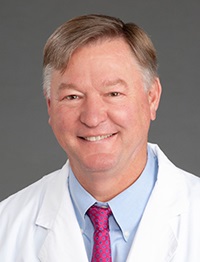

Executive: Jim Hoekstra, MD, president of High Point Medical Center; senior vice president and associate dean of clinical and academic network development for Wake Forest Baptist Health
Q. How does High Point Medical Center and the community benefit from being part of the Wake Forest Baptist Health system?
Hoekstra: Wake Forest Baptist has a very strong affinity in the High Point area as our referral hospital in our primary service area. This is the hospital that people say is ‘my hospital’ when they come here, but Wake Forest Baptist is the chosen referral hospital for this community that has the most history. It’s a natural fit for us to be affiliated with Wake Forest Baptist because patients can get everything in one stop.
Our Hayworth Cancer Center is an offshoot of the Comprehensive Cancer Center at Wake Forest Baptist. The same is true of our surgeons, cardiologists and other specialists. You get the same quality of care here that you do there, and sometimes it’s the same doctor who provides it.
We can do things we normally wouldn’t be able to do because of our relationship with and close proximity to Wake Forest Baptist. We’ve been able to add some specialty services because of that relationship, too. For us, we have more technology and more expertise here than we would have if we were a freestanding community hospital.
Q. What benefits do High Point Medical Center and the community bring to the Wake Forest Baptist Health system?
Hoekstra: Most of the 19 counties that are referral sources for Wake Forest Baptist are out to the west all the way out to the Tennessee border and all the way north to Virginia. To the east, we’re a significant source from Guilford, Randolph and northern Davidson counties. We provide access to those communities.
Often, we are able to help the system by providing localized care for medical needs in a less crowded or specialized environment, and that allows the system the opportunity to take on more emergent care in Winston-Salem.
We can do a lot of things here that many community hospitals can’t do. We’re also now going to be a site for some specialty care. We’re also rapidly becoming a teaching hospital, although not to the extent that Wake Forest Baptist is. As we grow, we will become a second training hospital in the system.
Q. How has philanthropic giving shaped High Point Medical Center?
Hoekstra: High Point is a very committed and very generous community. The people here see this as their hospital, and they give to it because they want it to be a good hospital, in terms of technology and our capabilities. If you look at our labs, our operating rooms, our Hayworth Cancer Center, our Congdon Heart and Vascular Center and other services, much of what we have that separates us from other community hospitals is provided by philanthropy and through our High Point Regional Health Foundation. You see a number of names on buildings, centers and programs here because people from this community give to this hospital.
Our foundation and people who support our mission provide us an edge that we need to provide care locally to patients who normally we might not be able to care for if we were a standard community hospital. We have extensive technology that a lot of places would envy, so we can keep more care here, which is nice for the people of High Point and for those people who donate to support us.
Q. What do you see as the future of philanthropy at High Point Medical Center?
Hoekstra: This hospital was built by the community in 1986, which means it is approaching 40 years old and beginning to show its age. As we keep up with technology, we also want our facility to be up to standards as a 21st century hospital. I don’t see us adding on wings or buildings as much as renovating what we have to make it what the community expects in terms of our ability to care for people.
The need to buy new equipment and stay ahead of the curve in providing cutting-edge care will continue. The amount of money we would have to invest on our own is never going to be enough, and we’re not alone. Medicine doesn’t survive without gifts and a philanthropic commitment from the community.
